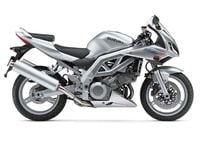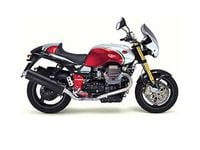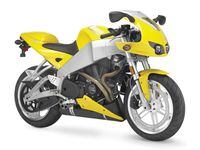Buried deep in the mission statement of every road-going sportbike is usually the requirement that some measure of civility be maintained so the bikes don't scare off potential buyers like snarling dogs in an animal shelter. The design team at Aprilia that penned the specs for the Tuono missed that memo. Although its wide handlebar and relatively upright seating position lend it the appearance of an obedient companion, make no mistake: The Tuono, with 126 hp and a 410-pound claimed dry weight, snaps at carelessly outstretched fingers and bites if mistreated.
Typically, naked versions of faired sportbikes get detuned engines, but the Tuono's 998cc 60-degree V-twin is virtually identical to the one in the 2002 RSV Mille, as are its frame, suspension, and brakes. The Tuono's riding position is a welcome change from the bent-over crouch enforced by sportier bikes, with a wide, flat handlebar and a seat that doesn't give you numb-bum after 30 minutes; the footpegs are high and tight, however. Suspension consists of a Showa fork and a Sachs/Boge rear shock; the Factory variation came with Öhlins suspension—gold anodized inverted fork, a racing rear shock with full adjustability, and a steering damper—along with stout Brembo brakes.
The power, especially the fat low-end torque curve, and lightweight made the Tuono a beast on back roads; one period test described it as “angry” and another as “the maddest motorcycle you can buy.” Our own EIC Cook took an early Tuono for a ride in ’03 and came back babbling about “an almost religious experience.” At the same time another MC tester complained the lack of weight on the front wheel made the bike unpredictably wheelie-prone, while a third expressed concern for the fate of his driver’s license were he to own a Tuono, lamenting the bike didn’t come with a “matching carbon-fiber and Kevlar attorney.” The Tuono might not be as viciously fast as the naked elite of 2015, but in its day it was a raucous ride.
In terms of overall reliability, the Tuono ranks high, suffering mostly minor problems that tend to reflect an individual bike’s use as opposed to a model-wide issue. Leaking fork seals and slipping clutches are natural by-products of the hooligan gene that lurks in the Tuono’s DNA. Even when ridden conservatively (yeah, like that’s gonna happen often) the big V-twin is thirsty, but the Rotax-built engine has proven to be extremely rugged. Less so the Tuono’s electrics, so check those carefully on any bike you’re considering. A starter that spins itself but not the engine likely means the sprag clutch has gone south. Front brake discs are prone to warping, and the rear is simply weak. Just about every other issue imaginable has been addressed on apriliaforum.com, the go-to Aprilia forum.
While mechanical reliability is very good, riders in wet climates complain about the durability of the bike’s finish when exposed to rain and road grit. That’s not to say they’re fair-weather bikes, just that if the one you’re thinking of buying is owned by someone who doesn’t subscribe to a strict cleaning regimen, be prepared to spend some time of your own bringing the shiny bits back to their original luster.
Stunning power, comfortable seating. Rolling incitement to riot.
Nosebleeds from unplanned wheelies as speedometer meets face, wind blast peeling you off the seat.
Bad electrics, blown fork seals, indifferent surface maintenance.
Pit bull on wheels. Grab its collar and hang on.
2003 / $4,095 2004 / $4,325 2005 / $4,655
A more amiable accomplice than the feisty Tuono, the SV1000 succeeded the star-crossed TL1000S. Its fuel-injected, 996cc V-twin put out a claimed 120 hp, and the claimed wet weight was 459 pounds. The naked version was dropped in 2004, and the half-faired S’s last year was 2007; neither proved as popular as the SV650.
“Sport” is a relative term, and the 1,064cc V11 was MG’s interpretation of sporty. At 546 pounds wet it’s no lightweight, nor will its 80 hp stretch your arms with brutal acceleration. But for sheer panache it’s hard to beat, with its knee-bashing cylinders, shaft drive, and beautifully intricate engine castings unshrouded by bodywork.
A tweaked 985cc Sportster V-twin in a beefy aluminum perimeter frame sounds like Frankenbike’s monster, and even though it had arguably the best Sporty engine ever, many riders felt the engine lacked the performance to match the chassis. Even so, the XB9’s tidy styling, quick steering, and unusual feature set found fans.














/cloudfront-us-east-1.images.arcpublishing.com/octane/7GJYDUIPXRGMTMQKN6ONYOLBOU.jpg)
/cloudfront-us-east-1.images.arcpublishing.com/octane/MUQLOVLL2ZDGFH25ILABNBXKTI.jpg)
/cloudfront-us-east-1.images.arcpublishing.com/octane/TNOU5DNE2BC57MFPMGN2EIDXAM.jpg)
/cloudfront-us-east-1.images.arcpublishing.com/octane/GTCXACQGJ5HAPDTGWUQKDEH44E.jpg)
/cloudfront-us-east-1.images.arcpublishing.com/octane/S35YGSEMEZB4BLTDJTSZPF4GLA.jpg)
/cloudfront-us-east-1.images.arcpublishing.com/octane/5UOT6HPX2JFMRJAX6EH45AR4MQ.jpg)
/cloudfront-us-east-1.images.arcpublishing.com/octane/OKWOJWAKP5EP3OACCRRWPCIX2Q.jpg)
/cloudfront-us-east-1.images.arcpublishing.com/octane/2WF3SCE3NFBQXLDNJM7KMXA45E.jpg)
/cloudfront-us-east-1.images.arcpublishing.com/octane/G4MG6OUCJNBSHIS2MVVOTPX65E.jpg)
/cloudfront-us-east-1.images.arcpublishing.com/octane/IIGGWFOTOJGB7DB6DGBXCCMTDY.jpg)
/cloudfront-us-east-1.images.arcpublishing.com/octane/QSTCM6AVEZA5JJBUXNIQ3DSOF4.jpg)
/cloudfront-us-east-1.images.arcpublishing.com/octane/U4I7G625B5DMLF2DVIJDFZVV6M.jpg)
/cloudfront-us-east-1.images.arcpublishing.com/octane/B6XD6LS6IVCQPIU6HXDJSM3FHY.jpg)
/cloudfront-us-east-1.images.arcpublishing.com/octane/ICL63FEDDRDTTMINYICCEYGMDA.jpg)
/cloudfront-us-east-1.images.arcpublishing.com/octane/FCGZHQXRBZFLBAPC5SDIQLVF4I.jpg)
/cloudfront-us-east-1.images.arcpublishing.com/octane/WNOB6LDOIFFHJKPSVIWDYUGOPM.jpg)

/cloudfront-us-east-1.images.arcpublishing.com/octane/X33NU3E525ECRHXLNUJN2FTRKI.jpg)
/cloudfront-us-east-1.images.arcpublishing.com/octane/6KKT5NNL2JAVBOXMZYS5ZO76YA.jpg)
/cloudfront-us-east-1.images.arcpublishing.com/octane/J5RKG5O455GMPGQRF2OG6LRT7A.jpg)
/cloudfront-us-east-1.images.arcpublishing.com/octane/GX2CIZKQVRH2TATDM26KFG2DAE.jpg)
/cloudfront-us-east-1.images.arcpublishing.com/octane/ZWIDYSAKQZHD5BHREMQILXJCGM.jpg)
/cloudfront-us-east-1.images.arcpublishing.com/octane/CYUHJZCTSJCH3MRAQEIKXK7SCQ.jpg)
/cloudfront-us-east-1.images.arcpublishing.com/octane/LKOFINY56FCXJCANJ5M7ZDQUBY.jpg)